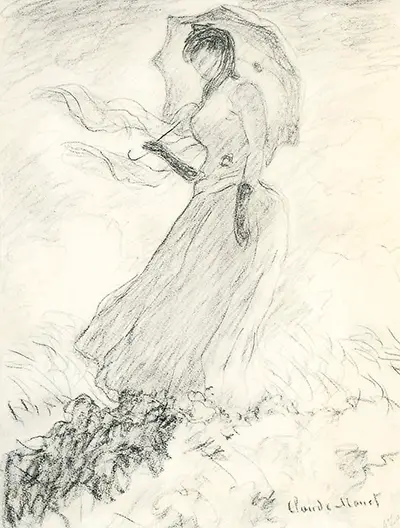The final oil on canvas was entitled Woman with a Parasol. Oscar-Claude Monet (1840 – 1926) was a French painter and founder of French Impressionist painting. Claude Monet's work, Woman with a Parasol drawing, is a sketchy drawing, typical of the Impressionist era. The work's viewpoint is below the woman, with a strong upward perspective. Claude Monet evokes a sense of movement by applying the medium in directional strokes. The artist also produced countless oil paintings and pastel artworks. This produces long, flowing lines which create the impression of blowing wind. The medium is mostly applied softly, with limited shading to produce an airy feel.
The faceless woman is free of identity. Her dress billows in the wind and her scarf is swept about her. The woman's surroundings are simply hinted at, there is grass beneath her feet and the faint outline of clouds in the sky above, but the location is open to interpretation. Claude Monet effectively creates a sense of movement and expansion which resists limits or definition. Impressionism was a movement that began in the late 1960s by a group of artists including Renoir and Cezanne and is an important movement in the history of art in the modern period. Impressionism was a separation from the conservative approach to art that dominated the art world throughout the Vanitas tradition. Impressionist artists believed that art should represent specifically contemporary sensibility. The movement and its artists, such as Claude Monet became very influential and developed into a division within the wider world of European culture.
Woman with a Parasol drawing appears to have been the basis upon which he created the painting, Woman with a Parasol, facing left, in 1886. Perspective, composition and minor details, from the shadow at her feet to the flower at her waist are identical. Again, Claude Monet captures the essence of a windy summers day. The painting is also a perfect example of Impressionist art. Claude Monet employs a narrow range of colour, dominantly featuring shades of pink, blue and green. Brushstrokes are directional, evoking the sense of movement significant in the drawing. Paint is applied thickly, with characteristic 'worrying' over outlines, contours and shading effects. Claude Monet's approach is experimentation and amplifies the sense of flow, freedom and expansion embodied in the drawing. The Impressionists endeavoured to create an impression as much as an artwork, and both the painting and the drawing are perfect examples of this.
Claude Monet produced several works of a woman with a parasol: Woman with a Parasol - Madame Monet and Her Son, 1875; Woman with a Parasol drawing; Woman with a Parasol, facing left, 1886; Woman with a Parasol, facing right, 1886. The woman in the works is identified as Monet's wife Camille Monet in the period from 1871 to 1877 while they and their son, Jean Monet, lived in Argenteuil, France. However, despite using his family as his inspiration for these works, Claude Monet bestows his works with an indefinite quality that allows them to be open to interpretation.


